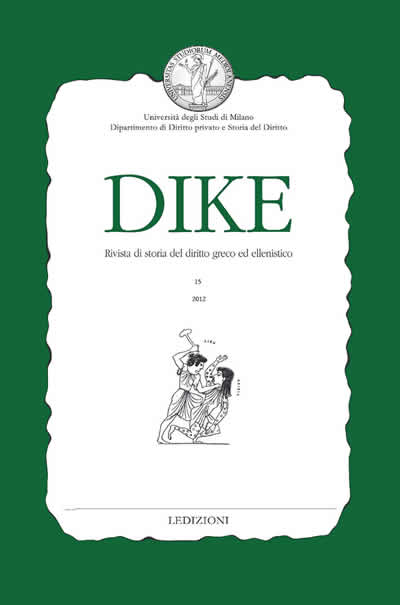RECHTS- UND VERFASSUNGSINSTRUMENTE ALS MITTEL DER KONFLIKTBEWÄLTIGUNG IN DER ATHENISCHEN DEMOKRATIE: STASISGESETZE, OSTRAKISMOS UND GRAPHE PARANOMON
DOI:
https://doi.org/10.13130/1128-8221/3490Abstract
Der Artikel versucht, einige Institutionen der athenischen Staats- und Rechtsordnung in ihrer Funktion als Mittel zur Konfliktbewältigung bzw. –prävention zu erfassen. Im Fokus stehen dabei das solonische Stasisgesetz, der Ostrakismos und die graphe paranomon. Bei dem angeblich solonischen Gesetz liegt die Problematik darin, dass es von seinem Wortlaut her eher zur Verschärfung als zur Lösung von Stasis-Situationen geeignet scheint. Da diverse neuere Deutungsversuche auf der Basis des überlieferten Textes keine wirklich überzeugenden Lösungen ergeben haben, scheint es gerechtfertigt, mit einer Korruption der Überlieferung des Gesetzeswortlauts zu rechnen.
This article attempts to view some institutes of Athenian public law as means of conflict resolution and conflict prevention. The focus lies on the Solonian law of stasis, ostracism and the graphe paranomon. The law attributed to Solon causes irritation because in the form handed downto us it seems prone to incite stasis rather than prevent it. As modern attempts to get a plausible meaning out of the text as it is remain unconvincing, it seems best to accept the possibility that a textual corruption has taken place in the transmission of the wording of Solon’s law. As far as ostracism is concerned, its effects in conflict resolution and prevention were twofold. Sometimes an ostracisms played a role in solving internal conflicts by bringing about a clear decision in favour of one or the other of the contesting factions. Moreover, the potential to prevent conflicts is inherent in the main function of the institution, insofar as the threat of being ostracized had a mitigating effect on the rivalries between elite politicians. The purpose of preventing conflicts can also be attributed to the graphe paranomon, the legal action against unconstitutional proposals. Here it lies mainly in the fact that the graphe paranomon had the potential to limit the escalation of conflicts arising from disputes about the legitimacy of popular decrees. The graphe paranomon could achieve this effect because it forced the parties concerned to seek the decision of their contests in the proceedings of a regular court. Notwithstanding their intended purposes, ostracism and the graphe paranomon were in practice subject to the risk of improper use. In the case of ostracism this fact was recognized by the Athenian public and the institution ceased to be used after 416 B.C. Regarding the graphe paranomon, however, the Athenians seem to have accepted the possibility of misapplication; in the fourth century B.C. they used it abundantly and in many cases not as an instrument to secure legitimacy, but as a weapon in the personal feuds between competing politicians.
Dowloads
Pubblicato
Fascicolo
Sezione
Licenza
- Gli autori mantengono i diritti sulla loro opera e cedono alla rivista il diritto di prima pubblicazione dell'opera, contemporaneamente licenziata sotto una Licenza Creative Commons - Attribuzione - Condividi allo stesso modo che permette ad altri di condividere l'opera indicando la paternità intellettuale e la prima pubblicazione su questa rivista.
- Gli autori possono aderire ad altri accordi di licenza non esclusiva per la distribuzione della versione dell'opera pubblicata (es. depositarla in un archivio istituzionale o pubblicarla in una monografia), a patto di indicare che la prima pubblicazione è avvenuta su questa rivista.
- Gli autori possono diffondere la loro opera online (es. in repository istituzionali o nel loro sito web) prima e durante il processo di submission, poichè può portare a scambi produttivi e aumentare le citazioni dell'opera pubblicata (Vedi The Effect of Open Access).





